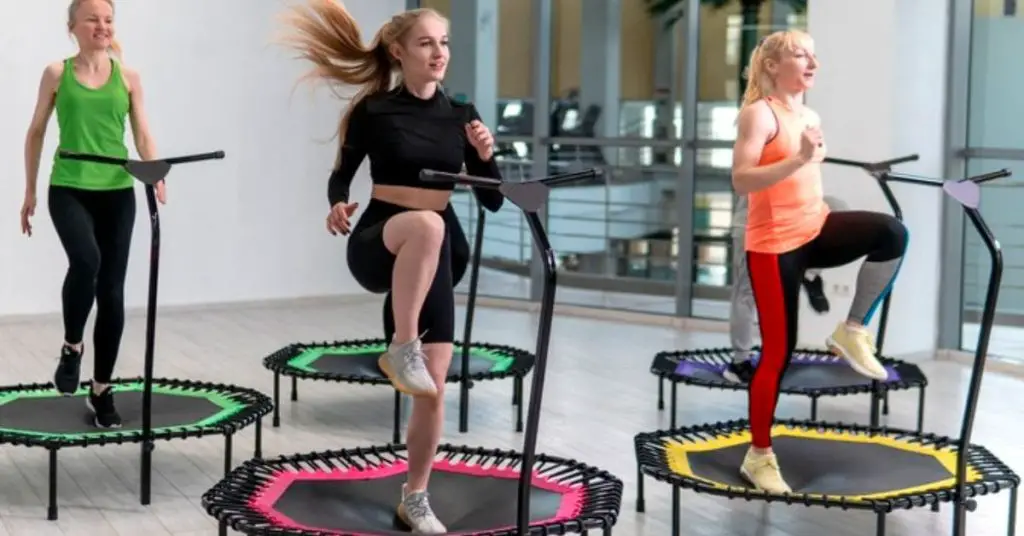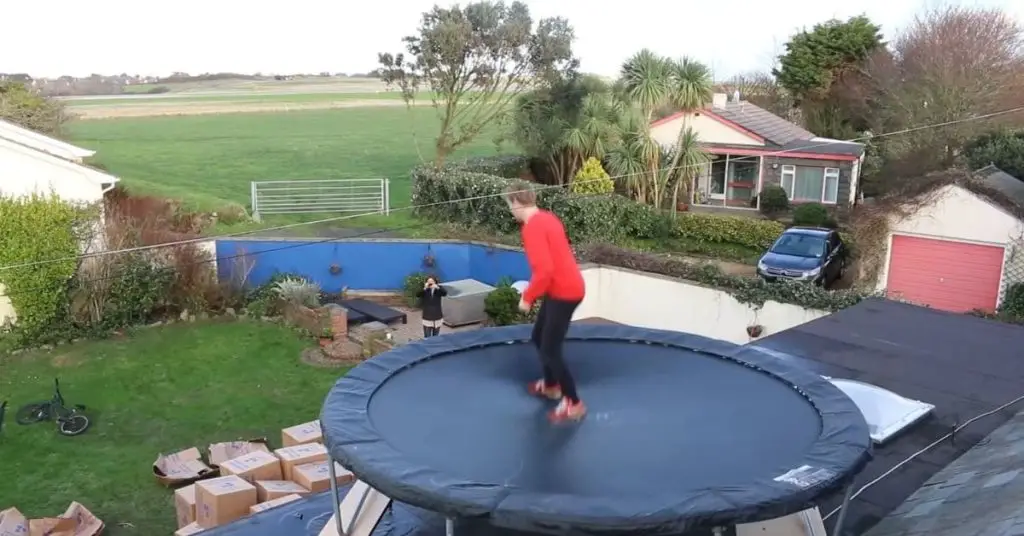Have you ever wondered “Why do I pee a little when I jump on the trampoline?” There are different opinions and rumors out there, but no clear answer. It seems to be a combination of factors.
One factor is how much water I’ve consumed before bouncing. If I’ve had a lot to drink, I’m more likely to need to use the restroom while on the trampoline. So, if I know I’ll be bouncing for a while, it’s best to cut back on fluids an hour or so before starting.
Another factor is how much food I’ve eaten. If my stomach is full, there’s more pressure on my bladder. I should wait at least an hour after eating before jumping.
The longer I bounce, the more likely it is that I’ll need to use the restroom because the pressure on my bladder increases. And age plays a role as children and elderly people are more likely to need to go while on a trampoline. It’s all because our bladder muscles are not as strong.
Why do I pee a little when I jump on trampoline: Trampolines can cause urinary leakage due to increased intra-abdominal pressure and stress on the bladder and pelvic floor muscles. Factors like weak pelvic floor muscles, previous childbirth, and age-related changes contribute to this issue.
Is Peeing while Jumping Normal?

Is it normal to experience bladder leakage, or peeing a little while jumping? Well, it’s actually more common than you might think. In fact, around 1 in 3 women experience stress incontinence, which is the main cause of peeing while jumping, at some point in their lives.
But why does it happen? Stress incontinence occurs when the muscles that control the bladder become weak or strained, leading to leakage when pressure is placed on the bladder, such as during jumping.
The good news is that there are steps you can take to prevent and manage stress incontinence.
What Causes Peeing while Jumping? Stress Incontinence.
If you leak urine when you jump, cough, or laugh, it’s likely because of stress incontinence. When you do physical activities like jumping, the pressure on your abdomen increases, putting pressure on your bladder.
Stress incontinence refers to the physical strain that causes urine leakage. It happens when the muscles that control urination, like the pelvic floor muscles, are weakened or damaged, making it harder to hold in urine.
Why do I Pee a little when I Jump on Trampoline: (10 reasons)
Here we discuss 10 reasons why do I pee a little when I jump on a trampoline:
1. Weak Pelvic Floor Muscles:
The pelvic floor muscles are a group of muscles located at the bottom of the pelvis, stretching from the pubic bone to the tailbone. They play a vital role in supporting the pelvic organs, including the bladder, uterus (in women), and rectum. These muscles also help control urinary and bowel movements.
Weak pelvic floor muscles can be a common cause of urinary leakage while jumping on a trampoline. When the pelvic floor muscles are weak or damaged, they may struggle to provide proper support to the bladder during physical activities like jumping.
This can result in stress incontinence, where urine is unintentionally released due to the pressure exerted on the bladder. Strengthening the pelvic floor muscles through targeted exercises, such as Kegels, can help improve muscle tone and control, reducing the likelihood of urinary leakage while jumping on a trampoline.
2. Previous Childbirth:
Childbirth can have a significant impact on the pelvic floor muscles. During vaginal delivery, the pelvic floor muscles undergo stretching and potential trauma as the baby passes through the birth canal.
This can lead to weakening or damage to the muscles, affecting their ability to provide adequate support to the pelvic organs.
Women who have given birth are at an increased likelihood of experiencing urinary leakage, particularly stress incontinence while jumping on a trampoline. The stress placed on the weakened pelvic floor muscles during jumping can cause urine to leak out due to compromised muscle control.
It is important for women who have gone through childbirth to be aware of this potential issue and take steps to strengthen their pelvic floor muscles through exercises and techniques prescribed by healthcare professionals.
Strengthening the muscles can help improve bladder control and reduce the risk of urinary leakage during physical activities like jumping on a trampoline.
3. Age-Related Changes:
As individuals age, the pelvic floor muscles naturally undergo changes. These changes can include a loss of muscle tone, decreased elasticity, and reduced overall strength. The weakening of the pelvic floor muscles can lead to decreased support for the bladder and other pelvic organs.
Older individuals are at an increased risk of experiencing urinary incontinence, including stress incontinence while jumping on a trampoline. The age-related changes in the pelvic floor muscles contribute to a higher likelihood of bladder control issues. The impact of jumping can put additional strain on the weakened muscles, resulting in urine leakage.
It is important for older individuals to be aware of these changes and take proactive measures to maintain pelvic floor muscle strength, such as performing regular exercises specifically targeting the pelvic floor, seeking guidance from healthcare professionals, and using protective measures like absorbent pads if needed.
By addressing these age-related changes, individuals can minimize the risk of urinary incontinence and enjoy physical activities with greater comfort and confidence.
4. Hormonal Factors:
Hormonal changes can have a significant influence on urinary control. Hormones, such as estrogen, play a crucial role in maintaining the health and function of the urinary tract and pelvic floor muscles.
When hormone levels fluctuate, particularly during certain phases of the menstrual cycle, pregnancy, menopause, or hormonal therapies, it can impact bladder control.
Fluctuations in hormone levels can contribute to urinary leakage, including stress incontinence while jumping on a trampoline. Decreased estrogen levels, for example, can lead to a loss of elasticity and strength in the tissues supporting the bladder and urethra.
This can result in reduced bladder control and an increased risk of urine leakage during activities that put pressure on the pelvic area, like jumping.
It is important for individuals experiencing hormonal changes to be aware of their potential impact on urinary control. Seeking medical advice and discussing concerns with healthcare professionals can help in managing hormonal imbalances and developing strategies to minimize urinary leakage while engaging in activities like trampolining.
This may involve hormone therapy, targeted exercises, and other interventions to support pelvic floor health and maintain bladder control.
5. Chronic Conditions:
Chronic conditions, such as urinary tract infections (UTIs) or urinary incontinence disorders, can contribute to urinary leakage while jumping on a trampoline.
Conditions like UTIs can cause irritation and inflammation in the urinary tract, leading to increased urgency and frequency of urination. This heightened sensitivity can make it more challenging to control bladder function during physical activities, including trampolining.
Similarly, individuals with underlying urinary incontinence disorders, such as overactive bladder or bladder muscle dysfunction, may experience difficulties in maintaining continence while engaging in activities with impact or pressure on the pelvic region.
Managing chronic conditions is essential for reducing the likelihood of urinary leakage during trampoline activities. This involves proper medical treatment and adherence to prescribed therapies or interventions for specific conditions.
Seeking guidance from healthcare professionals, such as urologists or specialists in urogynecology, can help individuals better understand their condition and develop strategies to minimize urinary leakage while enjoying trampolining or other physical activities.
6. Impact of Physical Activity:

When engaging in physical activities, such as jumping on a trampoline, there is an increase in intra-abdominal pressure. This pressure occurs due to the exertion and movements involved, including the bouncing and jumping motions.
The increased pressure can put additional stress on the bladder, which may contribute to urinary leakage.
Jumping on a trampoline can also place stress on the pelvic floor muscles. The pelvic floor muscles play a vital role in maintaining urinary control by supporting the bladder and urethra.
However, the repetitive impact and movements during trampolining can strain these muscles, potentially leading to weakened or damaged pelvic floor muscles.
When the pelvic floor muscles are weakened, it becomes more challenging to control urine flow, increasing the risk of urinary leakage during physical activities like jumping on a trampoline.
Understanding the impact of physical activity on the bladder and pelvic floor muscles is essential for managing urinary control while enjoying trampoline exercises. Strengthening the pelvic floor muscles through targeted exercises, such as Kegel exercises, can help improve muscle tone and support.
It is also important to maintain proper form and technique while jumping on the trampoline, as this can minimize the stress placed on the bladder and pelvic floor muscles.
Additionally, taking regular breaks, staying hydrated, and listening to your body’s signals can contribute to better urinary control during trampolining and other physical activities.
7. Excessive Fluid Intake:
There is a relationship between fluid intake and urinary leakage during physical activities. When you consume excessive amounts of fluids, especially close to the time of engaging in activities like jumping on a trampoline, it can increase the volume of urine in your bladder.
This increased bladder volume can put more pressure on the bladder, making it more difficult to maintain proper control and potentially leading to urinary leakage.
Overhydration, which refers to consuming more fluids than your body needs, can have an effect on bladder control during physical activities. When the bladder is overly full due to excessive fluid intake, it becomes more challenging to control the release of urine.
This can be particularly problematic during activities that involve movements and increased abdominal pressure, like jumping on a trampoline. The excess fluid puts additional strain on the bladder, making it more likely for urinary leakage to occur.
Maintaining a balanced fluid intake is important for bladder control during physical activities. It is recommended to drink an adequate amount of fluids to stay hydrated, but not to overhydrate.
Pay attention to your body’s hydration needs and consume fluids in moderation. By maintaining a healthy fluid balance, you can help prevent excessive bladder pressure and reduce the likelihood of urinary leakage while enjoying activities on a trampoline.
8. Improper Technique or Form:
Improper landing or jumping techniques can contribute to urinary leakage while engaging in activities like jumping on a trampoline. When you land forcefully or with excessive impact, it can put a strain on your pelvic floor muscles.
These muscles play a crucial role in maintaining urinary control. If you land improperly, such as landing on your heels instead of a soft bend in your knees, the impact can transfer to the pelvic floor muscles, potentially weakening them or causing them to become overstressed.
Improper form during trampoline activities can strain the pelvic floor muscles, leading to urinary leakage. When you don’t engage your core muscles properly or maintain proper alignment while jumping, it can put additional stress on the pelvic floor.
This strain can compromise the strength and stability of the pelvic floor muscles, making it more difficult to maintain urinary control during physical exertion.
It’s important to focus on proper technique and form, including landing softly, using a controlled motion, and engaging the core muscles to support the pelvic floor and minimize strain.
By practicing correct landing and jumping techniques, and ensuring proper form and alignment, you can reduce the strain on your pelvic floor muscles.
This can help maintain better urinary control while enjoying activities on a trampoline, minimizing the risk of urinary leakage and promoting overall pelvic health.
9. Psychological Factors:
Stress, anxiety, or fear of urinary leakage can contribute to urinary control issues while jumping on a trampoline. When you have concerns or worries about experiencing urinary leakage during physical activities, it can create psychological stress.
Stress and anxiety can activate the body’s “fight or flight” response, which can affect the muscles involved in urinary control, including the pelvic floor muscles. This heightened state of arousal can increase the likelihood of urinary leakage.
The psychological impact of stress, anxiety, or fear can have a direct influence on urinary control while jumping on a trampoline. Negative emotions and worries about urinary leakage can create a mental distraction, affecting your ability to maintain proper muscle control and coordination.
Additionally, the fear of embarrassment or discomfort associated with urinary leakage can further contribute to psychological stress and exacerbate the issue.
It is important to address and manage psychological factors related to urinary control. Strategies such as relaxation techniques, stress management, and building confidence can help reduce psychological stress and improve overall urinary control during physical activities on a trampoline.
By fostering a positive mindset and creating a supportive environment, you can enhance your ability to maintain urinary control and enjoy the activity without the psychological burden.
10. Medications and Diuretics:

Certain medications and diuretics can have an impact on bladder control, potentially leading to urinary leakage while jumping on a trampoline.
Some medications, such as diuretics, are specifically designed to increase urine production and promote fluid elimination from the body.
These substances can increase the frequency and urgency of urination, making it more challenging to maintain bladder control during physical activities.
The influence of medications and diuretics on urinary leakage during trampoline jumping is due to their effects on urine production and bladder function.
By increasing urine output, these substances can put additional strain on the bladder and make it harder to hold in urine, especially during activities that involve bouncing and increased abdominal pressure.
Additionally, some medications may have side effects that affect muscle control or relaxation, further impacting urinary control while jumping.
It is important to be aware of the potential effects of medications and diuretics on bladder control, particularly if you are prone to urinary leakage. If you are experiencing difficulties with urinary control while taking certain medications, it may be helpful to discuss this with your healthcare provider.
They can provide guidance and potentially adjust your medication regimen to minimize the impact on bladder function during physical activities like trampoline jumping.
How can I address or Manage Stress Incontinence?
The good news is that you can improve the strength of your pelvic floor muscles to help reduce or stop urine leakage during workouts, without needing medical treatment.
Weight Loss and Stress Incontinence:
Losing weight can also be beneficial in reducing or even eliminating stress incontinence. Dr. Rooney explains that losing around 20 to 30 pounds can have a significant impact on this condition.
However, it can be a bit challenging because while you exercise to lose weight, the physical activity itself can sometimes lead to urine leakage.
The Power of Kegel Exercises for Bladder Control:
One of the best ways to improve bladder control is by doing kegel exercises, which target the pelvic floor muscles. These muscles support the uterus, bladder, and rectum and can be strengthened through specific exercises.
To perform Kegels, imagine you’re trying to hold in urine as if you’re waiting in a long line for the bathroom. Contract the muscles in your pelvic floor and hold for three seconds, then release. Repeat this movement 10 to 15 times, gradually increasing the number over time.
It’s important to do kegels correctly, as many women tend to clench their buttocks or legs instead of engaging the proper muscles. If you’re having trouble, a physical therapist can assist you in identifying the correct muscles and provide guidance or pelvic floor stimulation.
In therapy sessions, you may do 50 to 100 repetitions to gradually strengthen the pelvic floor muscles and transition to doing Kegels independently.
Surgical Options for Stress Incontinence:
Surgery is not always necessary to address stress incontinence. There are simple measures that can help eliminate or reduce the problem. However, some women choose to undergo surgery to fix the issue.
The surgical procedure involves placing a sling or mesh around the urethra to restore its tone and position. It’s important to note that surgery is a personal choice, and while your doctor may suggest it, it’s not mandatory for addressing stress incontinence.
How can you Manage Urinary Leakage During Your Workout?
Perhaps you have attempted kegel exercises but didn’t find them effective, or you prefer not to seek medical treatment for urinary leakage. That’s perfectly fine! There are still ways to prevent urine leakage during your workout or at least hide it from others.
Managing Fluid Intake:
Of course, it’s important to drink enough water to stay hydrated. However, when you have a full bladder, it can put more pressure on your pelvic floor muscles and worsen stress incontinence. To reduce the chances of leakage, try to limit your water intake before and during your workout.
Additionally, make sure to empty your bladder right before you start exercising. This can help alleviate the discomfort and minimize the risk of urine leakage during your workout.
Moisture-Wicking Underwear:
Bladder control underwear doesn’t have to feel bulky like a diaper. Brands like Icon offer pee-proof underwear that is designed to keep you dry and odor-free. They use moisture-wicking material that can absorb up to six tablespoons of liquid.
The best part is that they come in different styles and colors, so you can feel comfortable and coordinated during your workout. Wearing this underwear can give you the confidence you need to exercise without worrying about leaks.
Avoiding Trampoline Use:

It may seem tempting to ignore the problem of leakage during physical activity, but avoiding it won’t make it go away. In fact, the issue can worsen over time if left unaddressed.
However, if you experience leakage during exercise, it’s important to take it as a sign to slow down a bit. It’s a signal that we need to find other solutions to help manage and address the problem effectively.
Vaginal Inserts:
If kegel exercises don’t work for you, there is another option called a high-impact pessary. It’s a vaginal insert that provides support to the urethra when you experience incontinence, such as during a workout.
“These inserts are temporary,” explains Dr. Rooney. “You insert the pessary when you need extra support, and remove it when you’re done with your workout.”
In simpler terms, the pessary is like a device that you can use temporarily to help prevent leakage during exercise, and you can take it out once you’re finished with your workout.
Tampons as a Solution:
Dr. Rooney has a helpful tip for her patients. She suggests using a thick tampon as a makeshift pessary to put pressure on the urethra and prevent urine leakage.
You can try different tampon absorbencies to find the one that provides enough pressure for you. Alternatively, the brand Poise offers Bladder Supports called Impressa that are similar to tampons and can be used instead if you prefer.
In simpler terms, using a thick tampon or specialized bladder supports can apply pressure on the urethra to help stop urine from leaking during physical activity.
Protection with Sanitary Products:
Pads and panty liners are useful for absorbing any extra liquid that may leak from your body, whether it’s during your period or during a workout. Just like tampons, pads, and panty liners come in different sizes and absorbency levels, so you can try different ones to find the right fit for you.
If you prefer more specialized options, you can choose bladder control pads made by brands like Poise. These pads are larger than regular ones and provide more coverage, ensuring that nothing seeps into your leggings or clothing.
In simpler terms, pads and panty liners are absorbent products that can help manage urine leakage during physical activity. You can try different sizes and brands to find the most suitable option for your needs. Bladder control pads offer extra coverage and protection for added peace of mind.
Related article: Can you jump on a trampoline when Pregnant
FAQs:
Q:1 Is it common to experience urine leakage while jumping rope?
When you jump rope, you may experience urine leakage if you’re not using your core muscles correctly. Your core is like a system that needs all its parts to work together to prevent discomfort and leaking.
Q:2 What can I do to prevent urine leakage when I jump?
To stop peeing when you jump, strengthen your pelvic floor muscles through exercises like Kegels, manage your fluid intake, use supportive inserts or pads, and consider consulting a healthcare professional for further guidance.
Q:3 Why do I experience unintentional urine leakage?
Stress incontinence happens when the muscles that help control urine flow become weak or damaged, leading to leakage during activities like jumping. Urge incontinence occurs when the bladder muscles become too active, causing a strong urge to urinate even when the bladder isn’t full.
Q:4 Is it normal to leak urine when I jump?
If you experience urine leakage while jumping, it’s called stress incontinence. It’s a good idea to see your doctor for an evaluation. They may refer you to a pelvic floor physiotherapist who can teach you exercises to strengthen your pelvic floor muscles correctly. These exercises can be effective, but it’s important to continue doing them regularly in the long term.
Q:5 What are the causes of having a weak pelvic floor?
Common factors that can weaken the pelvic floor include pregnancy, childbirth, prostate cancer treatment (in males), obesity, and chronic constipation. Pelvic floor exercises are designed to strengthen the muscles in that area and improve muscle tone. These exercises also help improve the connection between your brain and those muscles.
Q:6 How can I improve the strength of my bladder?
To prevent urine leakage, do pelvic floor muscle exercises, also called Kegel exercises. These exercises strengthen the muscles that control urine flow and can help prevent leaks when you sneeze, cough, lift, laugh, or feel a sudden need to urinate. Doing these exercises daily can make your pelvic floor muscles stronger.
Q:7 Can jumping exercises cause harm to the bladder?
Some people may leak urine when they jump or do activities that put pressure on the bladder. This is called stress incontinence. It can also happen when you cough, sneeze, or laugh. The extra pressure on the bladder causes the urine to leak out.
Conclusion:
In conclusion, experiencing urine leakage when jumping on a trampoline, known as stress incontinence, is a common occurrence for many individuals.
It is often caused by a combination of factors, including weakened pelvic floor muscles, previous childbirth, age-related changes, hormonal fluctuations, chronic conditions, impact of physical activity, excessive fluid intake, improper technique, and even psychological factors such as stress or anxiety.
While stress incontinence can be bothersome and embarrassing, there are various approaches to manage and alleviate this issue. Strengthening the pelvic floor muscles through exercises like Kegels can help improve bladder control and reduce leakage.
Maintaining a healthy weight and proper hydration can also play a role in managing stress incontinence. Additionally, using supportive inserts, such as pessaries or tampons, or wearing bladder control pads or urine-wicking underwear can provide temporary relief during physical activities.
It is important to consult with a healthcare professional, such as a doctor or pelvic floor physiotherapist, for proper diagnosis and guidance. They can assess the underlying causes and tailor a treatment plan that may include exercises, lifestyle modifications, or, in some cases, surgical options.
Remember, addressing stress incontinence is a personal choice, and with the right strategies, it is possible to minimize or overcome the challenges of urine leakage while enjoying physical activities like jumping on a trampoline.
We hope you will be well aware of “Why do I pee a little when I jump on trampoline”, after reading this comprehensive article. If you have any questions, feel free to comment below!

